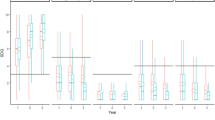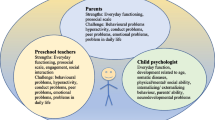Abstract
In a cross-sectional study, the prevalence rates of overall and specific mental health problems (MHP), as well as consequential impairments, were examined in a representative community sample of German preschoolers. MHP in 391 children were assessed by applying the Strength and Difficulties Questionnaire, as well as its impact supplement. Furthermore, the child behaviour checklist 1½–5 (CBCL 1½–5) and the IOWA-Conners behaviour rating scale were applied. Prevalence rates of MHP with 95 % confidence intervals (95 % CI) were determined. Odds ratios were calculated to analyse the relationships between MHP, age, gender, socioeconomic status, and geographical region using logistic regression. Overall, 7.4 % of the children showed symptoms of MHP. 12.9 % of the children were considered to be impaired by psychosocial problems. Depressive and anxiety symptoms were present in 4.2 % of the children; 11.8 % showed hyperactivity symptoms. The observed prevalence rates call for early mental health prevention in preschoolers.
Similar content being viewed by others
References
Angold A, Egger HL (2007) Preschool psychopathology: lessons for the lifespan. J Child Psychol Psychiatry 48(10):961–966
Costello EJ, Egger H, Angold A (2005) 10-year research update review: the epidemiology of child and adolescent psychiatric disorders: I. Methods and public health burden. J Am Acad Child Adolesc Psychiatry 44(10):972–986
Anselmi L et al (2008) Continuity of behavioral and emotional problems from pre-school years to pre-adolescence in a developing country. J Child Psychol Psychiatry 49(5):499–507
Beyer T, Postert C, Mueller JM, Furniss T (2012) Prognosis and continuity of child mental health problems from preschool to primary school: results of a 4-year longitudinal study. Child Psychiatry Hum Dev 43(4):533–543
Kessler RC et al (2005) Patterns and predictors of attention-deficit/hyperactivity disorder persistence into adulthood: results from the national comorbidity survey replication. Biol Psychiatry 57(11):1442–1451
Bufferd SJ, Dougherty LR, Carlson GA, Klein DN (2011) Parent-reported mental health in preschoolers: findings using a diagnostic interview. Compr Psychiatry 52(4):359–369
Lavigne JV, LeBailly SA, Hopkins J, Gouze KR, Binns HJ (2009) The prevalence of ADHD, ODD, depression, and anxiety in a community sample of 4-year-olds. J Clin Child Adolesc Psychol 38(3):315–328
Esbjorn BH, Hoeyer M, Dyrborg J, Leth I, Kendall PC (2010) Prevalence and co-morbidity among anxiety disorders in a national cohort of psychiatrically referred children and adolescents. J Anxiety Disord 24(8):866–872
World Health Organization (1992) The ICD-10 classification of mental and behavioural disorders: clinical descriptions and diagnostic guidelines. World Health Organization, Geneva
Elberling H, Linneberg A, Olsen EM, Goodman R, Skovgaard AM (2010) The prevalence of SDQ-measured mental health problems at age 5–7 years and identification of predictors from birth to preschool age in a Danish birth cohort: the Copenhagen child cohort 2000. Eur Child Adolesc Psychiatry 19(9):725–735
Wichstrom L et al (2012) Prevalence of psychiatric disorders in preschoolers. J Child Psychol Psychiatry 53(6):695–705
American Psychiatric Association (2000) Diagnostic and statistical manual of mental disorders, vol 4. American Psychiatric Association, Washingtion
Heiervang E, Goodman A, Goodman R (2008) The Nordic advantage in child mental health separating health differences from reporting style in a cross-cultural comparison of psychopathology. J Child Psychol Psychiatry 49(6):678–685
Barkmann C, Schulte-Markwort M (2012) Prevalence of emotional and behavioural disorders in German children and adolescents: a meta-analysis. J Epidemiol Community Health 66(3):194–203
Rudolph S, Franze M, Gottschling-Lang A, Hoffmann W (2013) Developmental risks for social skills of 3-to 6-year-old children at day-care centers: prevalence and risk factors. Kindheit und Entwicklung 22(2):97–104
Furniss T, Beyer T, Guggenmos J (2006) Prevalence of behavioural and emotional problems among 6-years-old preschool children. Soc Psychiatry Psychiatr Epidemiol 41(5):394–399
McDonnell MA, Glod C (2003) Prevalence of psychopathology in preschool-age children. J Child Adolesc Psychiatr Nurs 16(4):141–152
Carter AS et al (2010) Prevalence of DSM-IV disorder in a representative, healthy birth cohort at school entry: sociodemographic risks and social adaptation. J Am Acad Child Adolesc Psychiatry 49(7):686–698
Smolny W (2009) Wage adjustment, competitiveness and unemployment—East Germany after unificaiton. J Econ Stat 229(2/3):130–145
Ravens-Sieberer U, Kurth B-M, KiGGS study group, Bella study group (2008) The mental health module (BELLA study) within the German health interview and examination survey of children and adolescents (KiGGS): study design and methods. Eur Child Adolesc Psychiatry 17:10–21
Kurth BM (2007) KiGGS—was kommt danach? Gesundheitswesen 69(10):548–554
Woerner W et al (2002) Normative data and evaluation of the German parent-rated Strengths and Difficulties Questionnaire (SDQ): results of a representative field study. Z Kinder Jugendpsychiatr Psychother 30(2):102–112
Goodman R (1999) The extended version of the Strengths and Difficulties Questionnaire as a guide to child psychiatric caseness and consequent burden. J Child Psychol Psychiatry 40(5):791–799
Arbeitsgruppe Deutsche Child Behaviour Checklist (2002) Elternfragebogen für Klein- und Vorschulkinder (CBCL 1½–5). 2002, Köln: Arbeitsgruppe Kinder-, Jugend- und Familiendiagnostik (KJFD)
Atkins M, Milich R (1987) Iowa conners teacher rating scale. In: Hersen M, Bellack A (eds) Dictionary of behavioural assessment techniques. Pergamon Press, New York
Becker A, Woerner W, Hasselhorn M, Banasscheewski T, Rothenberger A (2004) Validation of the parent and teacher SDQ in a clinical sample. Eur Child Adolesc Psychiatry Suppl 13(2):II/11–II/16
Klasen H et al (2000) Comparing the German versions of the Strengths and Difficulties Questionnaire (SDD-Deu) and the Child behavior checklist. Eur Child Adolesc Psychiatry 9(4):271–276
Ezpeleta L, Granero R, de la Osa N, Penelo E, Domenech JM (2013) Psychometric properties of the Strengths and Difficulties Questionnaire in 3-year-old preschoolers. Compr Psychiatry 54:282–291
Stone LL, Otten R, Engels RCME, Vermulst AA, Janssens JMAM (2010) Psychometric properties of the parent and teacher versions of the Strengths and Difficulites Questionnaires for the 4- to 12- year-olds: a review. Clin Child Fam Psychol Rev 13:254–274
Achenbach TM (2000) Manual for the child behaviour checklist 1½–5. University of Vermont, Burlington, VT
Elting P Überprüfung der psychometrischen Parameter von CBCL 1 ½–5 und C-TRF an einer deutschen Stichprobe. Frankfurt am Main. Dissertation. Johann Wolfgang Goethe University
Conners CK (1969) A teacher rating scale for use in drug studies with children. Am J Psychiatry 126:884–888
Conners CK, Sitarenios G, Parker JD, Epstein JN (1998) The revised conners’ parent rating scale (CPRS-R): factor structure, reliability, and criterion validity. J Abnorm Child Psychol 26(4):257–268
Hosmer D, Lemeshow S (2000) Applied logistic regression, 2nd edn. Wiley, New York
Peduzzi P, Concato J, Kemper E, Holford TR, Feinstein AR (1996) A simulation study of the numer of events per variable in logistic regression analysis. J Clin Epidemiol 49(12):1373–1379
Lüdtke O, Robitzsch A, Trautwein U, Köller O (2007) Handling of missing data in psychological research: problems and solutions. Psychol Rundsch 58(2):103–117
SPSS Inc. (2009) PASW statistics for windows. SPSS Inc., Chicago
Ravens-Sieberer U et al (2008) Prevalence of mental health problems among children and adolescents in Germany: results of the BELLA study within the national health interview and examination survey. Eur Child Adolesc Psychiatry 17(SUPPL. 1):22–33
Wille N, Bettge S, Wittchen H-U, Ravens-Sieberer U, BELLA Study Group (2008) How impaired are children and adolescents by mental health problems? Results of the BELLA study. Eur Child Adolesc Psychiatry 17:42–51
Burns BJ et al (1995) Children’s mental health service use across service sectors. Health Aff 14(3):147–159
Laucht M, Esser G, Schmidt MH (2000) Longitudinal research on the developmental epidemiology of mental disorders: aims, concepts and major results of the mannheim study of risk children. Z Klin Psychol Psychother 29(4):246–262
Dopfner M et al (1997) Psychic disturbances of children and adolescents in Germany: results of respresentative survey: method, age, gender, and rater effects. Z Kinder Jugendpsychiatr Psychother 25:218–233
Ihle W, Esser G (2002) Epidemiology of mental disorders in childhood and adolescence: prevalence, course, comorbidity and gender differences. Psychol Rundsch 53(4):159–169
Froehlich-Gildhoff K, Roennau-Boese M (2012) Prevention of exclusion: the promotion of resilience in early childhoof institutions in disadvantaged areas. J Public Health 20:131–139
Winkler J, Stolzenberg H (1999) Der Sozialschichtindex im Bundesgesundheitssurvey. Gesundheitswesen 2:178–183
Author information
Authors and Affiliations
Consortia
Corresponding author
Ethics declarations
Conflict of interest
None of the authors declared conflicts of interest.
Ethical Statement
This study has been approved by the appropriate ethics committee of Medical Faculty of the Charité Berlin and has been performed in accordance with the ethical standards of the 1964 Declaration of Helsinki and its later amendments (see page 4).
Additional information
Olga Wlodarczyk and Silke Pawils are joint first authors.
The BELLA Study Group: Ulrike Ravens-Sieberer, Claus Barkmann, Susann Bettge, Monika Bullinger, Manfred Döpfner, Michael Erhart, Beate Herpertz-Dahlmann, Heike Hölling, Franz Resch, Aribert Rothenberger, Michael Schulte-Markwort, Nora Wille, Hans-Ulrich Wittchen.
Rights and permissions
About this article
Cite this article
Wlodarczyk, O., Pawils, S., Metzner, F. et al. Mental Health Problems Among Preschoolers in Germany: Results of the BELLA Preschool Study. Child Psychiatry Hum Dev 47, 529–538 (2016). https://doi.org/10.1007/s10578-015-0586-3
Published:
Issue Date:
DOI: https://doi.org/10.1007/s10578-015-0586-3




